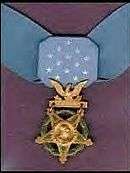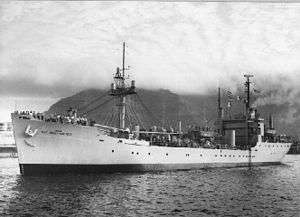Jose F. Valdez
| Jose F. Valdez | |
|---|---|
  PFC Jose F. Valdez, Medal of Honor recipient | |
| Born |
January 3, 1925 Gobernador, New Mexico |
| Died |
February 17, 1945 (aged 20) Rosenkranz, France |
| Allegiance | United States |
| Service/branch | United States Army |
| Years of service | 1944 - 1945 |
| Rank | Private First Class |
| Unit |
Company B 7th Infantry 3d Infantry Division |
| Battles/wars | World War II (Colmar Pocket) |
| Awards |
Medal of Honor Purple Heart |
Private First Class Jose F. Valdez (January 3, 1925 - February 17, 1945) was a United States Army soldier who posthumously received the Medal of Honor — the United States' highest military decoration — for his actions near Rosenkranz, France, in the Battle of the Colmar Pocket during World War II.
Early years
Valdez was a Mexican-American born and raised in Gobernador, New Mexico (today a ghost town). Though he never lived in Utah, he joined the United States Army upon the outbreak of World War II at a recruiting station in Pleasant Grove, Utah in June 1944 (thus officially listed as a Utah Medal of Honor recipient).[1] After completing his basic training, he was assigned to the 3rd Infantry Division.
World War II
The 3rd Infantry Division, which was under the command of Major General John W. O'Daniel, fought from North Africa through Sicily, Italy, France, and Germany during World War II. On January 23, 1945, the 3rd Infantry Division was attacking German forces in Alsace as part of the Allied offensive to collapse the Colmar Pocket.
On January 25, 1945, Valdez was on patrol with 5 of his fellow soldiers at a small railway station near Rosenkranz, France, (48°07′49.22″N 07°21′22.32″E / 48.1303389°N 7.3562000°E) when unexpectedly they confronted an enemy counterattack. An enemy tank was headed towards the patrol and Valdez, upon his own initiative, opened fire against the tank with his automatic rifle, action which made the tank withdraw. After Valdez killed 3 enemy soldiers in a firefight, the Germans ordered a full attack and sent in two companies of infantrymen.
Valdez offered to cover the members of his patrol when the platoon leader ordered a withdrawal. He fired upon the approaching enemy and his patrol members were able to reach American lines. Valdez was wounded and was able to drag himself back to American lines, however, he died three weeks later from his wounds.
Medal of Honor citation
- He was on outpost duty with 5 others when the enemy counterattacked with overwhelming strength. From his position near some woods 500 yards beyond the American lines he observed a hostile tank about 75 yards away, and raked it with automatic rifle fire until it withdrew. Soon afterward he saw 3 Germans stealthily approaching through the woods. Scorning cover as the enemy soldiers opened up with heavy automatic weapons fire from a range of 30 yards, he engaged in a fire fight with the attackers until he had killed all 3. The enemy quickly launched an attack with 2 full companies of infantrymen, blasting the patrol with murderous concentrations of automatic and rifle fire and beginning an encircling movement which forced the patrol leader to order a withdrawal. Despite the terrible odds, Pfc. Valdez immediately volunteered to cover the maneuver, and as the patrol 1 by 1 plunged through a hail of bullets toward the American lines, he fired burst after burst into the swarming enemy. Three of his companions were wounded in their dash for safety and he was struck by a bullet that entered his stomach and, passing through his body, emerged from his back. Overcoming agonizing pain, he regained control of himself and resumed his firing position, delivering a protective screen of bullets until all others of the patrol were safe. By field telephone he called for artillery and mortar fire on the Germans and corrected the range until he had shells falling within 50 yards of his position. For 15 minutes he refused to be dislodged by more than 200 of the enemy; then, seeing that the barrage had broken the counter attack, he dragged himself back to his own lines. He died later as a result of his wounds. Through his valiant, intrepid stand and at the cost of his own life, PFC Valdez made it possible for his comrades to escape, and was directly responsible for repulsing an attack by vastly superior enemy forces.[2]
Awards and recognitions
Awards
 Medal of Honor
Medal of Honor Purple Heart
Purple Heart American Campaign Medal
American Campaign Medal European-African-Middle Eastern Campaign Medal
European-African-Middle Eastern Campaign Medal World War II Victory Medal
World War II Victory Medal French Croix de guerre
French Croix de guerre French Croix de guerre Fourragère
French Croix de guerre Fourragère
Honors

- Valdez was buried with full military honors in the Santa Fe National Cemetery located in Santa Fe, New Mexico.[3][4]
- USNS Private Jose F. Valdez (T-AG-169), a technical research ship in operation during the 1960s.[5]
- Valdez Elementary School, an elementary School dedicated in north Denver, Colorado.[6]
- PFC Jose F. Valdez Memorial Highway, a 106-mile stretch of U.S. Route 64, from Tierra Amarilla to Bloomfield, in San Juan County, New Mexico.[7][8]
- Jose F. Valdez U.S. Army Reserve Center, located in Pleasant Grove, Utah, headquarters of the 405th Civil Affairs Battalion.
- A memorial to Valdez was dedicated in Gobernador, New Mexico, in 2002.[9][10]
- A memorial at All Veterans Memorial Park in Berg Park, New Mexico, was dedicated in 2009 honoring three northwest New Mexico residents who received the Medal of Honor; Valdez, USMC LCpl. Kenneth Lee Worley, and Army SSG Franklin D. Miller.[11]
See also
- List of Medal of Honor recipients for World War II
- Hispanic Medal of Honor recipients
- Hispanic Americans in World War II
References
- ↑ NM Resident join Army in UT
- ↑ Medal of Honor Citation
- ↑ Santa Fe National Cemetery
- ↑ Find a grave
- ↑ USNS Jose F. Valdez
- ↑ Valdez Elementary School
- ↑ Final Agenda
- ↑ New Mexico to honor 3rd ID WWII Medal of Honor Recipient
- ↑ Watch on the Rhine, August, 2002
- ↑ Valdez memorial
- ↑ Memorial 'Is a Legacy That Will Go on'
External links
- "Jose F. Valdez". Retrieved September 29, 2010.
- "Article on Valdez Memorial Dedication". Retrieved May 11, 2011.